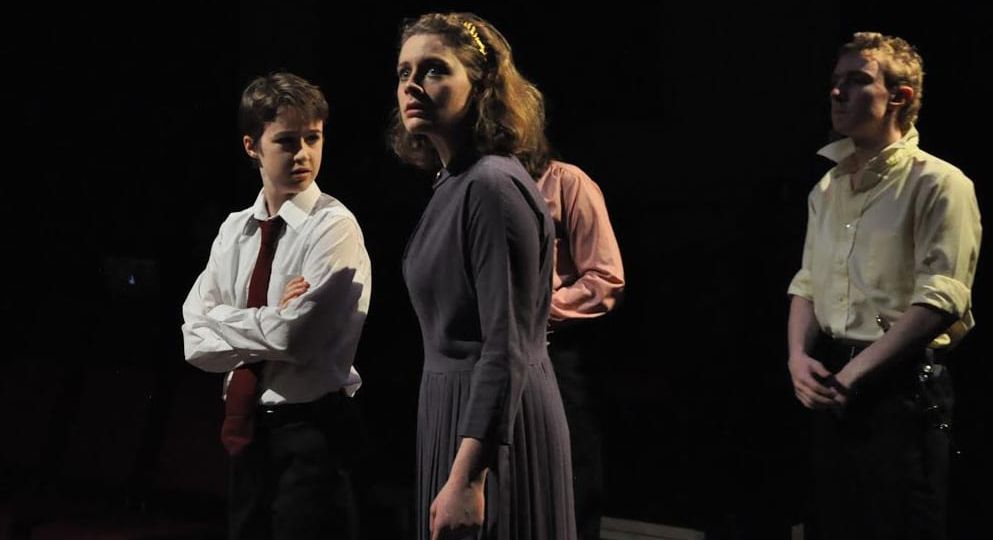
Staging Shakespeare generally runs the risk of falling prey to one of two major traps. Often performers overvalue authenticity and do a disservice to the material by making it traditional, stodgy and boring. On the other end of the spectrum, the effort to break out of the mold can be overextended and experimentation gives way to flashiness without underlying substance and a reliance on the popular taste of the moment. If St. Olaf’s depiction of “Julius Caesar” – directed by Chaz Mayo ’18 – dallies into either camp, it is only into the latter, but never for long enough to detract from the overall performance.
Put on in the compact Haugen Theater, the audience was packed in on three sides around the stage and character entrances cut through the seated sections. A student group, the Blue Chameleon string quartet, offered live accompaniment from the stage floor, and their performance was juxtaposed with modern pop-punk and rock interludes, where recorded music was used. This amounted to an intimate relationship between the audience and performers, intensifying the dramatic effects of the acting.
The staging itself was somewhat experimental, but mostly refreshing. Typical scenes of Shakespearean dialogue were interposed with impressively choreographed, and sometimes surreal interludes. These portions of the performance often elaborated upon relationships suggested by the text, with the majority featuring dancing or otherwise choreographed action that served to break up the otherwise dialogue-heavy play.
However, as is always the risk with such a story that has been so continuously told, some of these interludes ran the risk of confusing the main story by portraying characters in an atypical or tonally inconsistent light. An extended scene between Cassius and Casca follows the two discussing their planned murder of Caesar and has the two comedically dance with one another to the Scissor Sisters’ song “I Can’t Decide,” which has a chorus that extends to “whether you should live or die.” While certainly comical and effectively portrayed, the interaction offered a certain flippancy to their plan to kill Caesar that felt somewhat incongruous with later depictions of their attitude towards the assassination and the weight of it. While entertaining, this aside felt more like a break from the show than an addition to the text.
However, other interludes offered interesting points of engagement to the story. This is exemplified in the introduction, which shows much of the cast boisterously dancing to aggressive party music following a military victory. Caesar himself then enters and asserts his control, forcing various people to bow simply with arm gestures.
The depiction of Caesar maintained its strength throughout. Ben Habel ’19 offered an authoritative performance that helped to suggest the character’s weight and influence without needing to outright state it. His visual implementation in the performance added to this, particularly as he straight-backedly towered over other characters, before and after his ultimate demise.
The depiction of Brutus by Ian Sutherland ’18 was also enthralling as he managed to capture the, often misguided, earnestness of a character who is made a political player without the clear interest. However, useful nuance was offered in clear flashes of ambition. Sutherland’s performance played well off of Bjorn Long ’19 as Cassius, whose ambition was simultaneously compelling and repellant. The cause to assassinate Caesar was effectively portrayed as a fraught issue, and the play does not offer a clear answer as to who should be vindicated by the play’s end.
Caesar’s cause is excitingly portrayed by Christine Menge ’18 as Marc Antony and Bianca Davis ’21 as Octavius. Menge’s delivery of the famous “Friends, romans, countrymen” speech was very well performed, and their ongoing vision of Antony as an avenging force kept the conflict of the second half interesting. Davis’ Octavius brought fire to the performance in an excitingly wrathful and violent streak characterized in the character’s introduction.
However, the true breakaway performer of the show was Jeffrey Nolan ’20, who portrayed Casca and a number of secondary characters. He brought a humor that brilliantly broke up the otherwise serious show, including the disinterested, sarcastic Casca, as well as Artemidorus – a snivelly defender of Caesar – with sweater sleeves covering his hands.
The remainder of the parts were portrayed by Meredith Enersen ’21 and Alice Tibbetts ’20, who both offered strong performances and helped to fill out the world of the play.
campbe1@stolaf.edu









